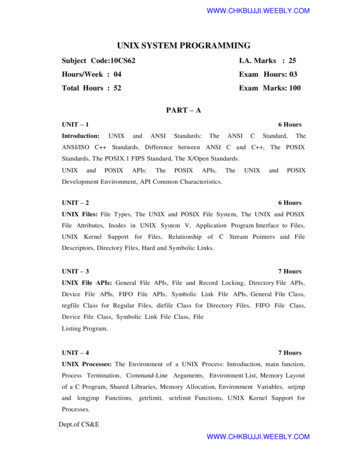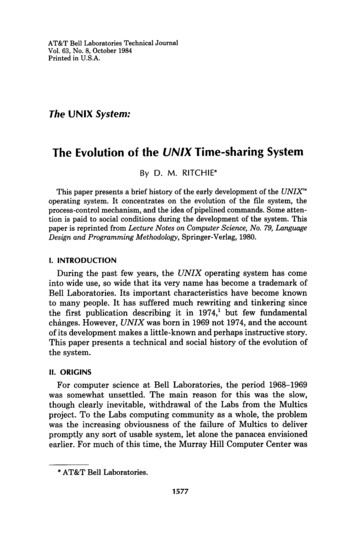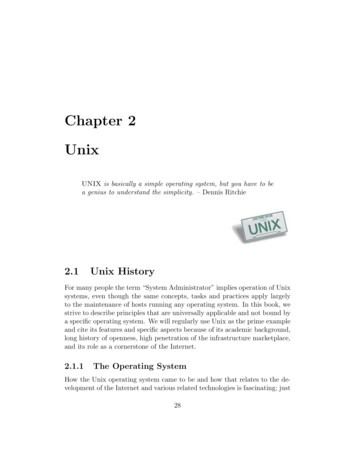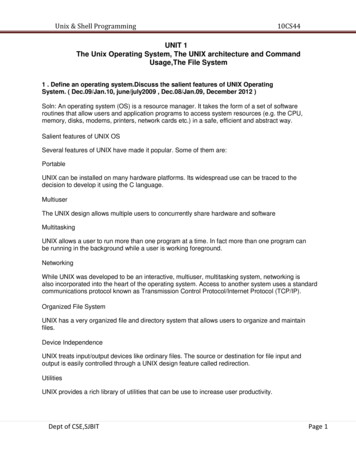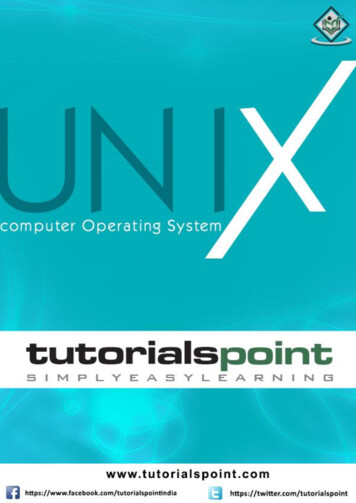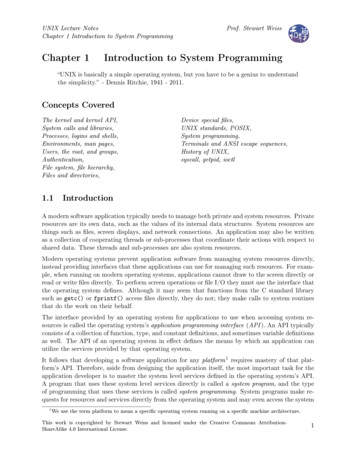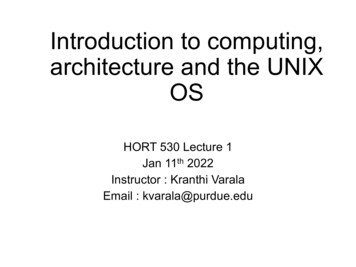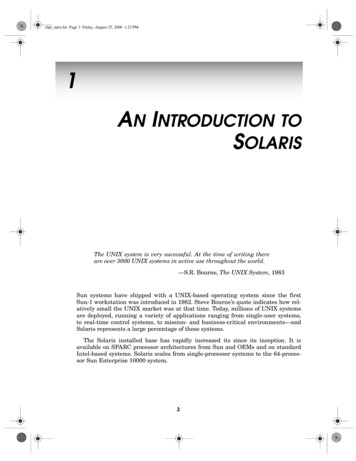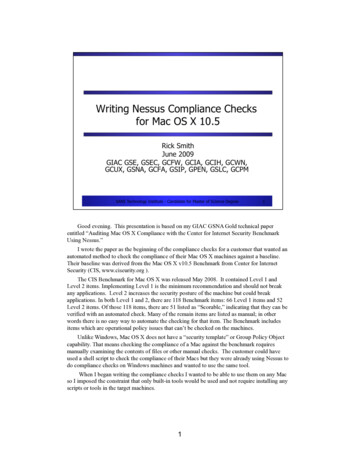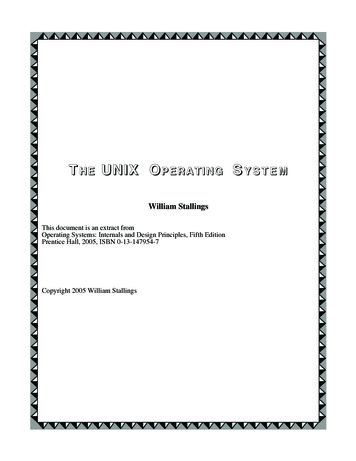
Transcription
T HE UNIX O PERATING S Y S T E MWilliam StallingsThis document is an extract fromOperating Systems: Internals and Design Principles, Fifth EditionPrentice Hall, 2005, ISBN 0-13-147954-7Copyright 2005 William Stallings
T ABLEOFCONTENTS2.6 TRADITIONAL UNIX SYSTEMS.3History.3Description.42.7 MODERN UNIX SYSTEMS .5System V Release 4 (SVR4) .5Solaris 9.64.4BSD.63.5 UNIX SVR4 PROCESS MANAGEMENT.7Process States.7Process Description.9Process Control .134.5 SOLARIS THREAD AND SMP MANAGEMENT .15Multithreaded Architecture.15Motivation.16Process Structure.18Thread Execution .18Interrupts as Threads.206.7 UNIX CONCURRENCY MECHANISMS.22Pipes.22Messages .23Shared Memory.23Semaphores .23Signals.256.9 SOLARIS THREAD SYNCHRONIZATION PRIMITIVES .27Mutual Exclusion Lock.27Semaphores .28Readers/Writer Lock.28Condition Variables .298.3 UNIX AND SOLARIS MEMORY MANAGEMENT .31Paging System.31Data Structures.31Page Replacement.34Kernel Memory Allocator.359.3 TRADITIONAL UNIX SCHEDULING.3810.4 UNIX SVR4 SCHEDULING .4011.8 UNIX SVR4 I/O.42Buffer Cache .42Character Queue.43Unbuffered I/O.44UNIX Devices.4412.7 UNIX FILE MANAGEMENT .46Inodes.46File Allocation.48Directories.49Volume Structure .49-2-
2.6 TRADITIONAL UNIX SYSTEMSHistoryThe history of UNIX is an oft-told tale and will not be repeated in great detail here. Instead, weprovide a brief summary.UNIX was initially developed at Bell Labs and became operational on a PDP-7 in 1970.Some of the people involved at Bell Labs had also participated in the time-sharing work beingdone at MIT's Project MAC. That project led to the development of first CTSS and then Multics.Although it is common to say that the original UNIX was a scaled-down version of Multics, thedevelopers of UNIX actually claimed to be more influenced by CTSS [RITC78]. Nevertheless,UNIX incorporated many ideas from Multics.Work on UNIX at Bell Labs, and later elsewhere, produced a series of versions of UNIX.The first notable milestone was porting the UNIX system from the PDP-7 to the PDP-11. Thiswas the first hint that UNIX would be an operating system for all computers. The next importantmilestone was the rewriting of UNIX in the programming language C. This was an unheard-ofstrategy at the time. It was generally felt that something as complex as an operating system,which must deal with time-critical events, had to be written exclusively in assembly language.The C implementation demonstrated the advantages of using a high-level language for most ifnot all of the system code. Today, virtually all UNIX implementations are written in C.These early versions of UNIX were popular within Bell Labs. In 1974, the UNIX systemwas described in a technical journal for the first time [RITC74]. This spurred great interest in thesystem. Licenses for UNIX were provided to commercial institutions as well as universities. Thefirst widely available version outside Bell Labs was Version 6, in 1976. The follow-on Version7, released in 1978, is the ancestor of most modern UNIX systems. The most important of thenon-AT&T systems to be developed was done at the University of California at Berkeley, calledUNIX BSD (Berkeley Software Distribution), running first on PDP and then VAX machines.AT&T continued to develop and refine the system. By 1982, Bell Labs had combined several-3-
AT&T variants of UNIX into a single system, marketed commercially as UNIX System III. Anumber of features was later added to the operating system to produce UNIX System V.DescriptionFigure 2.14 provides a general description of the UNIX architecture. The underlying hardware issurrounded by the operating system software. The operating system is often called the systemkernel, or simply the kernel, to emphasize its isolation from the user and applications. Thisportion of UNIX is what we will be concerned with in our use of UNIX as an example in thisbook. However, UNIX comes equipped with a number of user services and interfaces that areconsidered part of the system. These can be grouped into the shell, other interface software, andthe components of the C compiler (compiler, assembler, loader). The layer outside of thisconsists of user applications and the user interface to the C compiler.A closer look at the kernel is provided in Figure 2.15. User programs can invoke operatingsystem services either directly or through library programs. The system call interface is theboundary with the user and allows higher-level software to gain access to specific kernelfunctions. At the other end, the operating system contains primitive routines that interact directlywith the hardware. Between these two interfaces, the system is divided into two main parts, oneconcerned with process control and the other concerned with file management and I/O. Theprocess control subsystem is responsible for memory management, the scheduling anddispatching of processes, and the synchronization and interprocess communication of processes.The file system exchanges data between memory and external devices either as a stream ofcharacters or in blocks. To achieve this, a variety of device drivers are used. For block-orientedtransfers, a disk cache approach is used: a system buffer in main memory is interposed betweenthe user address space and the external device.The description in this subsection has dealt with what might be termed traditional UNIXsystems; [VAHA96] uses this term to refer to System V Release 3 (SVR3), 4.3BSD, and earlierversions. The following general statements may be made about a traditional UNIX system. It is-4-
UNIX Commandsand LibrariesSystem sFigure 2.14 General UNIX Architecture
User ProgramsTrapLibrariesUser LevelKernel LevelSystem Call InterfaceInter-processcommunicationFile SubsystemProcessControlSubsystemBuffer CachecharacterSchedulerMemorymanagementblockDevice DriversHardware ControlKernel LevelHardware LevelHardwareFigure 2.15 Traditional UNIX Kernel [BACH86]
designed to run on a single processor and lacks the ability to protect its data structures fromconcurrent access by multiple processors. Its kernel is not very versatile, supporting a single typeof file system, process scheduling policy, and executable file format. The traditional UNIXkernel is not designed to be extensible and has few facilities for code reuse. The result is that, asnew features were added to the various UNIX versions, much new code had to be added,yielding a bloated and unmodular kernel.2.7 MODERN UNIX SYSTEMSAs UNIX evolved, the number of different implementations proliferated, each providing someuseful features. There was a need to produce a new implementation that unified many of theimportant innovations, added other modern operating system design features, and produced amore modular architecture. Typical of the modern UNIX kernel is the architecture depicted inFigure 2.16. There is a small core of facilities, written in a modular fashion, that providefunctions and services needed by a number of operating system processes. Each of the outercircles represents functions and an interface that may be implemented in a variety of ways.We now turn to some examples of modern UNIX systems.System V Release 4 (SVR4)SVR4, developed jointly by AT&T and Sun Microsystems, combines features from SVR3,4.3BSD, Microsoft Xenix System V, and SunOS. It was almost a total rewrite of the System Vkernel and produced a clean, if complex, implementation. New features in the release includereal-time processing support, process scheduling classes, dynamically allocated data structures,virtual memory management, virtual file system, and a preemptive kernel.SVR4 draws on the efforts of both commercial and academic designers and was developedto provide a uniform platform for commercial UNIX deployment. It has succeeded in thisobjective and is perhaps the most important UNIX variant. It incorporates most of the important-5-
coffa.outelfexecswitchNFSfile itiesdisk cessestape driverSTREAMSnetworkdriverttydriverFigure 2.16 Modern UNIX Kernel [VAHA96]time-sharingprocesses
features ever developed on any UNIX system and does so in an integrated, commercially viablefashion. SVR4 is running on machines ranging from 32-bit microprocessors up tosupercomputers. Many of the UNIX examples in this book are from SVR4.Solaris 9Solaris is Sun's SVR4-based UNIX release, with the latest version being 9. Solaris provides all ofthe features of SVR4 plus a number of more advanced features, such as a fully preemptable,multithreaded kernel, full support for SMP, and an object-oriented interface to file systems.Solaris is the most widely used and most successful commercial UNIX implementation. Forsome operating system features, Solaris provides the UNIX examples in this book.4.4BSDThe Berkeley Software Distribution (BSD) series of UNIX releases have played a key role in thedevelopment of operating system design theory. 4.xBSD is widely used in academic installationsand has served as the basis of a number of commercial UNIX products. It is probably safe to saythat BSD is responsible for much of the popularity of UNIX and that most enhancements toUNIX first appeared in BSD versions.4.4BSD was the final version of BSD to be released by Berkeley, with the design andimplementation organization subsequently dissolved. It is a major upgrade to 4.3BSD andincludes a new virtual memory system, changes in the kernel structure, and a long list of otherfeature enhancements.The latest version of the Macintosh operating system, Mac OS X, is based on 4.4BSD.-6-
3.5 UNIX SVR4 PROCESS MANAGEMENTUNIX System V makes use of a simple but powerful process facility that is highly visible to theuser. UNIX follows the model of Figure 3.15b, in which most of the operating system executeswithin the environment of a user process. Thus, two modes, user and kernel, are required. UNIXuses two categories of processes: system processes and user processes. System processes run inkernel mode and execute operating system code to perform administrative and housekeepingfunctions, such as allocation of memory and process swapping. User processes operate in usermode to execute user programs and utilities and in kernel mode to execute instructions thatbelong to the kernel. A user process enters kernel mode by issuing a system call, when anexception (fault) is generated, or when an interrupt occurs.Process StatesA total of nine process states are recognized by the UNIX operating system; these are listed inTable 3.9 and a state transition diagram is shown in Figure 3.17 (based on figure in [BACH86]).This figure is similar to Figure 3.9b, with the two UNIX sleeping states corresponding to the twoblocked states. The differences can be summarized quickly: UNIX employs two Running states to indicate whether the process is executing in usermode or kernel mode. A distinction is made between the two states: (Ready to Run, in Memory) and (Preempted).These are essentially the same state, as indicated by the dotted line joining them. Thedistinction is made to emphasize the way in which the preempted state is entered. When aprocess is running in kernel mode (as a result of a supervisor call, clock interrupt, or I/Ointerrupt), there will come a time when the kernel has completed its work and is ready toreturn control to the user program. At this point, the kernel may decide to preempt thecurrent process in favor of one that is ready and of higher priority. In that case, the current-7-
eduleprocesspreemptAsleep inMemorywakeupReady to RunIn Memoryenoughmemoryswap outswap inswap outSleep,SwappedwakeupReady to RunSwappednot enough memory(swapping system only)Figure 3.17 UNIX Process State Transition Diagraminterrupt,interrupt returnsystem call,interruptreturnto userPreemptedCreatedfork
process moves to the preempted state. However, for purposes of dispatching, thoseprocesses in the preempted state and those in the Ready to Run, in Memory state form onequeue.Preemption can only occur when a process is about to move from kernel mode to usermode. While a process is running in kernel mode, it may not be preempted. This makes UNIXunsuitable for real-time processing. A discussion of the requirements for real-time processing isprovided in Chapter 10.Two processes are unique in UNIX. Process 0 is a special process that is created when thesystem boots; in effect, it is predefined as a data structure loaded at boot time. It is the swapperprocess. In addition, process 0 spawns process 1, referred to as the init process; all otherprocesses in the system have process 1 as an ancestor. When a new interactive user logs onto thesystem, it is process 1 that creates a user process for that user. Subsequently, the user process cancreate child processes in a branching tree, so that any particular application can consist of anumber of related processes.-8-
Table 3.9 UNIX Process StatesUser RunningExecuting in user mode.Kernel RunningExecuting in kernel mode.Ready to Run, in Memory Ready to run as soon as the kernel schedules it.Asleep in MemoryUnable to execute until an event occurs; process is in main memory(a blocked state).Ready to Run, SwappedProcess is ready to run, but the swapper must swap the process intomain memory before the kernel can schedule it to execute.Sleeping, SwappedThe process is awaiting an event and has been swapped tosecondary storage (a blocked state).PreemptedProcess is returning from kernel to user mode, but the kernelpreempts it and does a process switch to schedule another process.CreatedProcess is newly created and not yet ready to run.ZombieProcess no longer exists, but it leaves a record for its parent processto collect.Process DescriptionA process in UNIX is a rather complex set of data structures that provide the operating systemwith all of the information necessary to manage and dispatch processes. Table 3.10 summarizesthe elements of the process image, which are organized into three parts: user-level context,register context, and system-level context.-9-
Table 3.10 UNIX Process ImageUser-Level ContextProcess textProcess dataUser stackShared memoryProgram counterProcessor status registerStack pointerGeneral-purpose registersProcess table entryU (user) areaPer process region tableKernel stackExecutable machine instructions of the programData accessible by the program of this processContains the arguments, local variables, and pointers for functionsexecuting in user modeMemory shared with other processes, used for interprocesscommunicationRegister ContextAddress of next instruction to be executed; may be in kernel oruser memory space of this processContains the hardware status at the time of preemption; contentsand format are hardware dependentPoints to the top of the kernel or user stack, depending on the modeof operation at the time or preemptionHardware dependentSystem-Level ContextDefines state of a process; this information is always accessible tothe operating systemProcess control information that needs to be accessed only in thecontext of the processDefines the mapping from virtual to physical addresses; alsocontains a permission field that indicates the type of accessallowed the process: read-only, read-write, or read-executeContains the stack frame of kernel procedures as the processexecutes in kernel modeThe user-level context contains the basic elements of a user's program and can begenerated directly from a compiled object file. The user's program is separated into text and dataareas; the text area is read-only and is intended to hold the program's instructions. While theprocess is executing, the processor uses the user stack area for procedure calls and returns andparameter passing. The shared memory area is a data area that is shared with other processes.There is only one physical copy of a shared memory area, but, by the use of virtual memory, itappears to each sharing process that the shared memory region is in its address space. When aprocess is not running, the processor status information is stored in the register context area.The system-level context contains the remaining information that the operating systemneeds to manage the process. It consists of a static part, which is fixed in size and stays with aprocess throughout its lifetime, and a dynamic part, which varies in size through the life of the-10-
process. One element of the static part is the process table entry. This is actually part of theprocess table maintained by the operating system, with one entry per process. The process tableentry contains process control information that is accessible to the kernel at all times; hence, in avirtual memory system, all process table entries are maintained in main memory. Table 3.11 liststhe contents of a process table entry. The user area, or U area, contains additional process controlinformation that is needed by the kernel when it is executing in the context of this process; it isalso used when paging processes to and from memory. Table 3.12 shows the contents of thistable.The distinction between the process table entry and the U area reflects the fact that theUNIX kernel always executes in the context of some process. Much of the time, the kernel willbe dealing with the concerns of that process. However, some of the time, such as when the kernelis performing a scheduling algorithm preparatory to dispatching another process, it will needaccess to information about other processes. The information in a process table can be accessedwhen the given process is not the current one.The third static portion of the system-level context is the per process region table, which isused by the memory management system. Finally, the kernel stack is the dynamic portion of thesystem-level context. This stack is used when the process is executing in kernel mode andcontains the information that must be saved and restored as procedure calls and interrupts occur.-11-
Table 3.11 UNIX Process Table EntryProcess statusCurrent state of process.PointersTo U area and process memory area (text, data, stack).Process sizeEnables the operating system to know how much space to allocatethe process.User identifiersThe real user ID identifies the user who is responsible for therunning process. The effective user ID may be used by a processto gain temporary privileges associated with a particular program;while that program is being executed as part of the process, theprocess operates with the effective user ID.Process identifiersID of this process; ID of parent process. These are set up when theprocess enters the Created state during the fork system call.Event descriptorValid when a process is in a sleeping state; when the event occurs,the process is transferred to a ready-to-run state.PriorityUsed for process scheduling.SignalEnumerates signals sent to a process but not yet handled.TimersInclude process execution time, kernel resource utilization, anduser-set timer used to send alarm signal to a process.P linkPointer to the next link in the ready queue (valid if process is readyto execute).Memory statusIndicates whether process image is in main memory or swappedout. If it is in memory, this field also indicates whether it may beswapped out or is temporarily locked into main memory.-12-
Table 3.12 UNIX U AreaProcess table pointerIndicates entry that corresponds to the U area.User identifiersReal and effective user IDs. Used to determine user privileges.TimersRecord time that the process (and its descendants) spent executingin user mode and in kernel mode.Signal-handler arrayFor each type of signal defined in the system, indicates how theprocess will react to receipt of that signal (exit, ignore, executespecified user function).Control terminalIndicates login terminal for this process, if one exists.Error fieldRecords errors encountered during a system call.Return valueContains the result of system calls.I/O parametersDescribe the amount of data to transfer, the address of the source(or target) data array in user space, and file offsets for I/O.File parametersCurrent directory and current root describe the file systemenvironment of the process.User file descriptor tableRecords the files the process has open.Limit fieldsRestrict the size of the process and the size of a file it can write.Permission modes fieldsMask mode settings on files the process creates.Process ControlProcess creation in UNIX is made by means of the kernel system call, fork( ). When a processissues a fork request, the operating system performs the following functions [BACH86]:1. It allocates a slot in the process table for the new process.2. It assigns a unique process ID to the child process.3. It makes a copy of the process image of the parent, with the exception of any sharedmemory.4. It increments counters for any files owned by the parent, to reflect that an additionalprocess now also owns those files.-13-
5. It assigns the child process to the Ready to Run state.6. It returns the ID number of the child to the parent process, and a 0 value to the childprocess.All of this work is accomplished in kernel mode in the parent process. When the kernel hascompleted these functions it can do one of the following, as part of the dispatcher routine:1. Stay in the parent process. Control returns to user mode at the point of the fork call of theparent.2. Transfer control to the child process. The child process begins executing at the samepoint in the code as the parent, namely at the return from the fork call.3. Transfer control to another process. Both parent and child are left in the Ready to Runstate.It is perhaps difficult to visualize this method of process creation because both parent andchild are executing the same passage of code. The difference is this: when the return from thefork occurs, the return parameter is tested. If the value is zero, then this is the child process, anda branch can be executed to the appropriate user program to continue execution. If the value isnonzero, then this is the parent process, and the main line of execution can continue.-14-
4.5 SOLARIS THREAD AND SMP MANAGEMENTSolaris implements an unusual multilevel thread support designed to provide considerableflexibility in exploiting processor resources.Multithreaded ArchitectureSolaris makes use of four separate thread-related concepts: Process: This is the normal UNIX process and includes the user's address space, stack, andprocess control block. User-level threads: Implemented through a threads library in the address space of aprocess, these are invisible to the operating system. User-level threads (ULTs)1 are theinterface for application parallelism. Lightweight processes: A lightweight process (LWP) can be viewed as a mappingbetween ULTs and kernel threads. Each LWP supports one or more ULTs and maps to onekernel thread. LWPs are scheduled by the kernel independently and may execute in parallelon multiprocessors. Kernel threads: These are the fundamental entities that can be scheduled and dispatchedto run on one of the system processors.Figure 4.15 illustrates the relationship among these four entities. Note that there is alwaysexactly one kernel thread for each LWP. An LWP is visible within a process to the application.Thus, LWP data structures exist within their respective process address space. At the same time,each LWP is bound to a single dispatchable kernel thread, and the data structure for that kernelthread is maintained within the kernel's address space.1Again, the acronym ULT is unique to this book and is not found in the Solaris literature.-15-
LUser-level threadHardwareKernelUserProcess 1Kernel threadPLPLLProcess 4L Lightweight ProcessPLProcess 3PPLProcessorLThreadsLibraryProcess 5Figure 4.15 Solaris Multithreaded Architecture ExampleLProcess 2PL
In our example, process 1 consists of a single ULT bound to a single LWP. Thus, there is asingle thread of execution, corresponding to a traditional UNIX process. When concurrency isnot required within a single process, an application uses this process structure. Process 2corresponds to a pure ULT strategy. All of the ULTs are supported by a single kernel thread, andtherefore only one ULT can execute at a time. This structure is useful for an application that canbest be programmed in a way that expresses concurrency but for which it is not necessary tohave parallel execution of multiple threads. Process 3 shows multiple threads multiplexed on alesser number of LWPs. In general, Solaris allows applications to multiplex ULTs on a lesser orequal number of LWPs. This enables the application to specify the degree of parallelism at thekernel level that will support this process. Process 4 has its threads permanently bound to LWPsin a one-to-one mapping. This structure makes the kernel-level parallelism fully visible to theapplication. It is useful if threads will typically or frequently be suspended in a blocking fashion.Process 5 shows both a mapping of multiple ULTs onto multiple LWPs and the binding of aULT to a LWP. In addition, one LWP is bound to a particular processor.Not shown in the figure is the presence of kernel threads that are not associated with LWPs.The kernel creates, runs, and destroys these kernel threads to execute specific system functions.The use of kernel threads rather th
some operating system features, Solaris provides the UNIX examples in this book. 4.4BSD The Berkeley Software Distribution (BSD) series of UNIX releases have played a key role in the development of operating system design theory. 4.xBSD is widely used in academic installations and has served as the basis
